Sorin F-18 Hornet and F/A 18 SuperHornet Page
| Name |
F18 Hornet |
| Contracter |
McDonnel-Douglas
|
| Purpose |
Universal
Fighter for the Navy |
| Description |
meant to replace the ageing F14 Tomcat |
| Other |
is smaller, cheaper and better than the F14 Tomcat |
| Performance |
it is more maneouvrable than the MiG29 at low speeds |
| Maximum speed |
Mach 1.8 |
| Maximum altitude |
15000 m |
| Cost/unit |
25 million dollars |
| Year of appearence |
1978 |
| Propulsion |
2x Pratt&Whitney F100/220 turbofans |
| Beneficiars |
US Navy |
| |
US Marine Corps |
| |
Australia, Canada, Finland, Denmark |
| |
Saudi Arabia, Israel, Spain, Norway |
In the late 1970s, the US Navy was looking for a new fighter, which could replace the F14 Tomcat, who appeared only in late 1970, but it was already becoming obsolete when compared to the new russian developments, like the top secret MiG29 Fulcrum and the classified Su27 Flanker.
In 1974, Boeing finished the F15 Egale, which entered in service in the same year. The F15 Eagle was the best fighter of the time, but Boeing has built it specifically to fit the Air Force's requirements, not the Navy's.
So now, the US Navy wanted a fighter build especially for it, and the F18 was just what they were looking for.
This aircraft proved to be the F18 Hornet.
The F18 Hornet is cheaper, more manoevrable and more advanced than the F15 Eagle, and it's characteristics enable it to resist at tough landings on the carrier. The F15 Eagle was well fitted to land on a carrier, but it was not specifically meant for it, so there was room for something better.
The F18, by being smaller, has automaticaly a better resistance at tough landings. Also, the rhudders are placed further forward on the engines, and the engines are brought closed to each other, all these characteristics making the structure much more resistent at shocks. The F14 Tomcat, on the other hand, has a huge distance between its nossels, and the rhudders end just before the nossels of the engines are starting, so that puts a lot of stress on the airframe at a carrier landing.
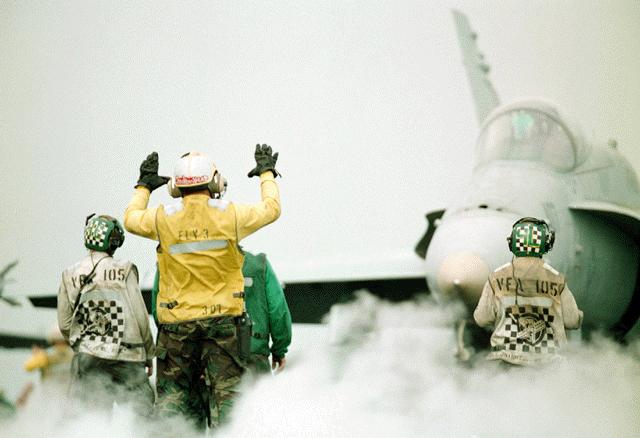 |
The SuperHornet during take-off procedure
|
McDonnel-Douglas produced the F18 Hornet, and many countries found in it just the aircraft they needed.
Canada operates the F18 Hornet, for its all-weather capabilities, Israel, a traditional american aircraft buyer also uses the F18, Saudi Arabia has decided that the F18 is the aircraft fitted for desert operations, also Finland, who has small air force bases near the borders found in the F18 the tough fighter able to take-off and land on improvised small runways, etc.
At the time, the french (as always) had their own project for a navy fighter, to replace their aging Etendard fighters. D'assault camed up with an upgrade to the Etendard, the SuperEtandard. However, the F-18 was (and is) a lot better than the SuperEtendard by every mean, so many french officials
oposed to the SuperEtendard, and proposed instead the aquisition of american F18s. But as always, nationalism won in France, and the SuperEtendard was chosen, although it had lower performances and higher producing and researching costs than it would be for the french government to just buy american F18s. The same thing is happening right now, when the french want to produce their own Rafale and Rafale M, instead of buying foreign aircraft, and not spending so many funds for developing a fighter with inferior capabilities and more expensive than others.
So, as a result, even if many french officials are against the project, the Rafale is expected to enter service in the near future, with huge development costs and a very poor price/performance report.
 The Hornet firing its impressive arsenal The Hornet firing its impressive arsenal
|
The F18 Hornet is still in active service in all of the countries that have it, and it will continues to do so for probably a long time.
F18 Hornets were extensevly used in the Gulf War in 1991, even if the undoubtebley stars of that war were the F14 Tomcat and the F15 Eagle.
In the Gulf, the F18s launched laser-guided bombs, doing the job they were ment for: fight their way in enemy theritory, attack multiple targets with precision munnition and then fight their way back.
The F18 Hornet was also used in Operation Desert Fox, flying from US carriers and from US Marines' bases in Saudi Arabia or Turkey. But a large part of them took-off from USS Enterprise and USS Carl Vinson.
 |
The Hornet and the most maneouvrable aircraft in the world, the X-31
|
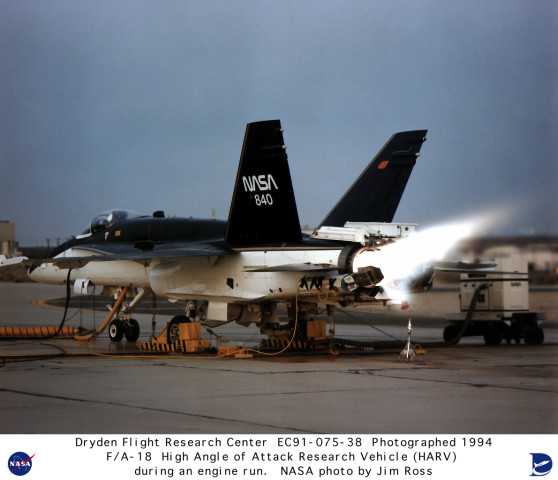 F-18 High Angle of Attack Research Vehicle F-18 High Angle of Attack Research Vehicle
|
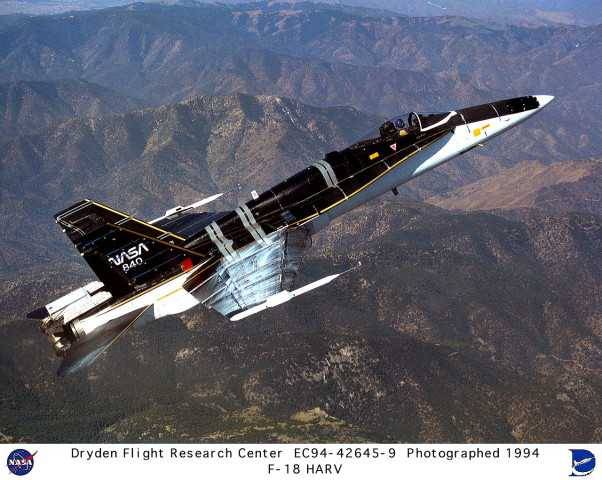 F-18 High Angle of Attack Research Vehicle F-18 High Angle of Attack Research Vehicle
|
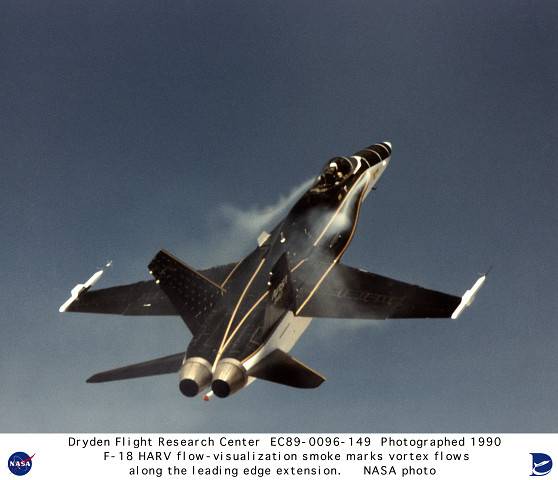 F-18 High Angle of Attack Research Vehicle F-18 High Angle of Attack Research Vehicle
|
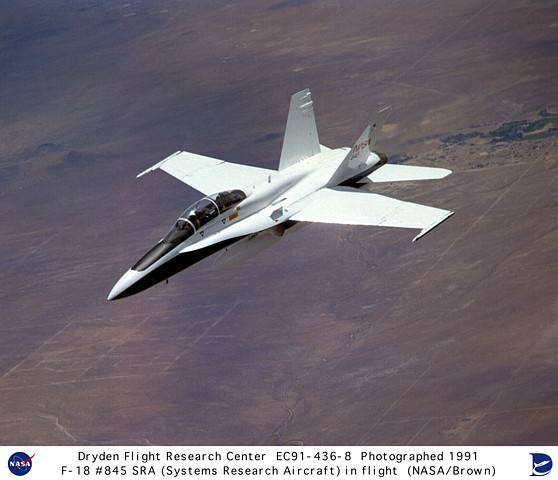 F-18 Systems Research Aircraft F-18 Systems Research Aircraft
|
 F/A 18 and F14 side by side aboard USS Carl Vinson, 1999 F/A 18 and F14 side by side aboard USS Carl Vinson, 1999
|
In this case, you can observe an F/A18C Hornet and an F14 Tomcat on the USS Carl Vinson carrier deck in 1999. In the background of the picture, you can bearly see an F/A14D+ Bombcat that was doing a sea-level supersonic flight in that particular morning. The F14 entered supersonic speed, and then the left engine exploded in front of everybody. Trying it's landing on the carrier, the F14 can be seen approaching carefuly in this picture. Since I don't have any other pics or video of the incident, I'm gonna tell you what happened with it: it failed the landing procedure and the two pilots ejected into the sea and were immediatly recovered by a SH60 Sea Hawk rescue helicopter. They both survived the ejection without any shocks, but the 30 million dollars Tomcat was lost. The pilot was around his 14th or so supersonic flight, which is a pretty high nomber.
 F/A 18 Hornet F/A 18 Hornet
|
Coming up, pictures from the F/A 18 Korea flight simulator. I wasn't the one who's flying.
 F/A 18 Korea F/A 18 Korea
F/A18C Hornet fully loaded at burner take-off
|
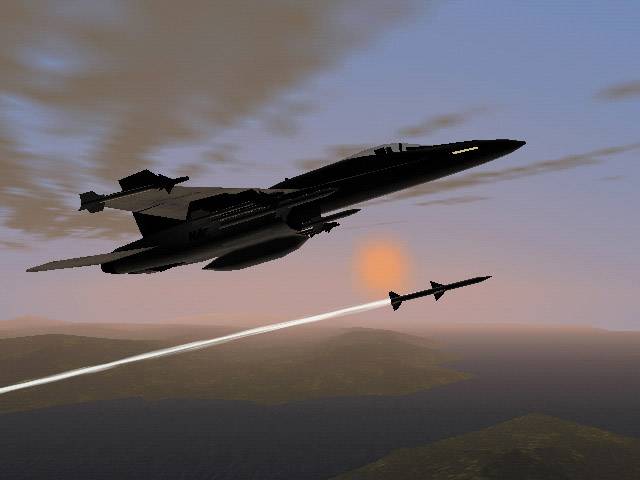 F/A 18 Korea - Navy Hornet firing an AMRAAM F/A 18 Korea - Navy Hornet firing an AMRAAM
|
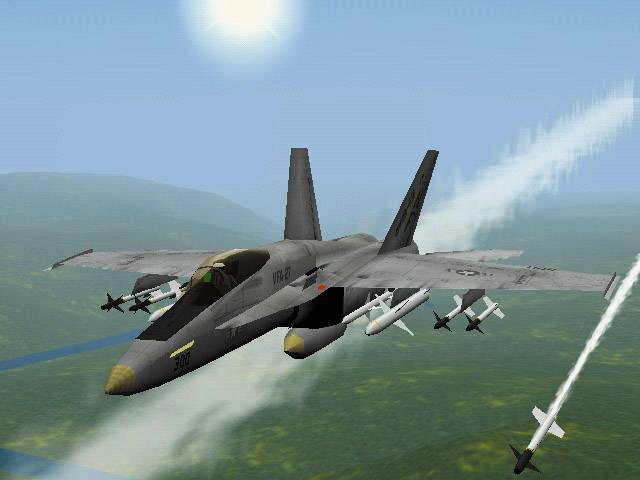 F/A 18 Korea - VMFA 27's 318th firing a Sidewinder F/A 18 Korea - VMFA 27's 318th firing a Sidewinder
|
F18 Hornets are still being used in Operation Allied Force in Kosovo, where they take-off from USS Enterprise and attack serbian military sites in Kosovo and the Republic of Serbska. See my article about that too.
But not all the F18s are fighting and killing people over the world.
The Blue Angels, America's most famous aerial demo team is flying on the F18s.
The Blue Angels were in many countries among the years, including Romania, and each demo they make is different from all the others before.
Information about the Northrop-Grumman F/A 18 E/F SuperHornet
 Name F/A 18 E/F SuperHornet
Name F/A 18 E/F SuperHornet
Producer Northrop-Grumman Corp
Purpose Universal Fighter for Navy
Maximum speed Mach 1.8
Other Info 9G/-4G, meant to replace the F14 Tomcat and A6 Intruder
Models known F/A 18 A, F/A 18 B, F/A 18 C, F/A 18 D Hornet
F/A 18 E1, F/A 18 E2, F/A 18 F1, F/A 18 F2 SuperHornet
- seen here in the left |
In the
picture above you can see the F/A 18 F2
SuperHornet
The F/A 18
SuperHornet is meant to replace the F18 Hornet for the future. At
the beginning of the 1980s, both the US Air Force and the US
Navy, as well as the US Marines wanted a new fighter, to replace
the current F15s, F18s and F16s.
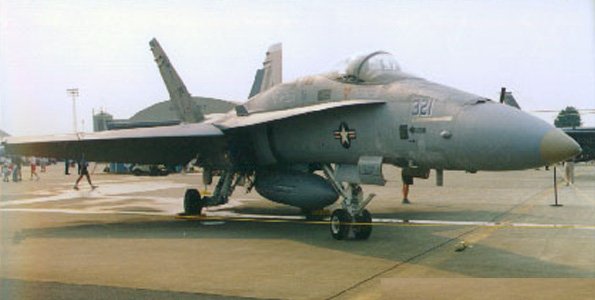 American F/A 18C Hornet American F/A 18C Hornet
|
The aircraft for the job prooved to be the F/A 18 SuperHornet, the F22 Raptor and the Joint Strike Fighter.
F/A 18 SuperHornet is 25% bigger than a classic F18, it has a new
radar, a longer range by 40% and on each wing one more pylon on each wing
for weapons.
The F/A 18 E/F SuperHornet's First Flight was in 1993, while the
F/A 18 E1 SuperHornet's First Flight was in November 29th, 1995.
The F/A 18 SuperHornet is so advanced, that it actually takes-off
from the aircraft carrier automatically, thanks to its computers.
The pilot just sits back and relax during the take-off, and than,
after 15 seconds, he takes over the control.
Many modern american fighters can also land automatically on the
carrier, but the people who coordinate the landings prefer to
deal with humans...
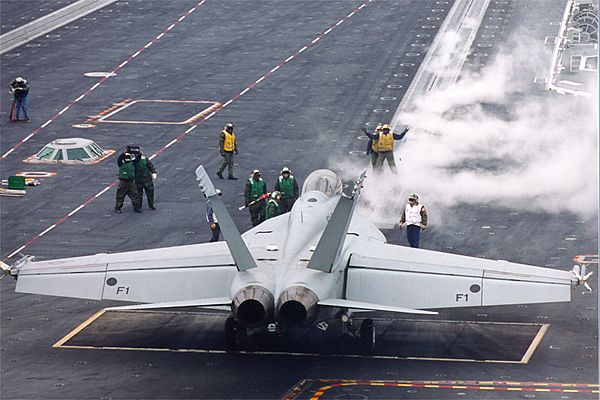 US Navy F/A 18 F1 SuperHornet at carrier take-off testing US Navy F/A 18 F1 SuperHornet at carrier take-off testing
|
F/A 18 SuperHornets were used in Operation Desert Fox in Irak,
december 1998, where they attacked iraqi air defenses and
military sites.
The SuperHornets tooked-off from USS Enterprise and then later
from USS Carl Vinson and attacked iraqi military sites in and
near the city of Baghdad and the city of Basra, as well as
targets in the north of Iraq.
F/A 18 SuperHornets are still used in Operation Allied Force in
Kosovo, where they attack serbian military sites.
The F/A 18s are taking-off from USS Enterprise and attack sites
in Kosovo, as well as in the Republic of Serbska and Muntenegro.
Sorin F/A 18 Hornet and F/A 18 E/F SuperHornet page
is ©1999 by Sorin A Crasmarelu from Sorin®
updated 2001 by Sorin A Crasmarelu
Some of the
pictures are provided by the US Navy
All rights
reserved

 The Hornet firing its impressive arsenal
The Hornet firing its impressive arsenal
 F-18 High Angle of Attack Research Vehicle
F-18 High Angle of Attack Research Vehicle F-18 High Angle of Attack Research Vehicle
F-18 High Angle of Attack Research Vehicle F-18 High Angle of Attack Research Vehicle
F-18 High Angle of Attack Research Vehicle F-18 Systems Research Aircraft
F-18 Systems Research Aircraft F/A 18 and F14 side by side aboard USS Carl Vinson, 1999
F/A 18 and F14 side by side aboard USS Carl Vinson, 1999 F/A 18 Hornet
F/A 18 Hornet F/A 18 Korea
F/A 18 Korea F/A 18 Korea - Navy Hornet firing an AMRAAM
F/A 18 Korea - Navy Hornet firing an AMRAAM F/A 18 Korea - VMFA 27's 318th firing a Sidewinder
F/A 18 Korea - VMFA 27's 318th firing a Sidewinder Name F/A 18 E/F SuperHornet
Name F/A 18 E/F SuperHornet American F/A 18C Hornet
American F/A 18C Hornet US Navy F/A 18 F1 SuperHornet at carrier take-off testing
US Navy F/A 18 F1 SuperHornet at carrier take-off testing